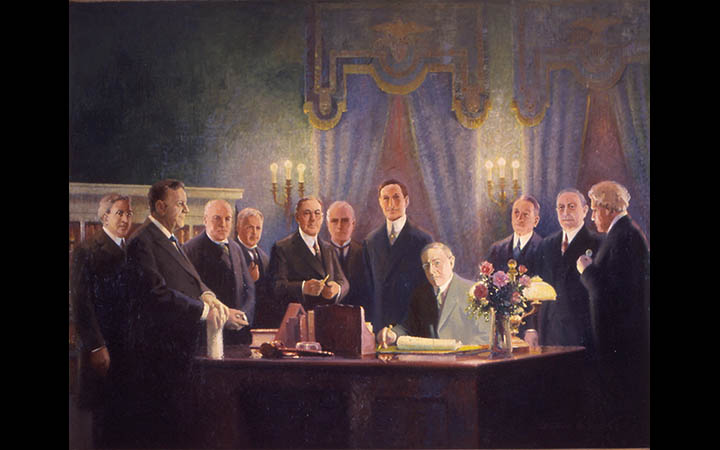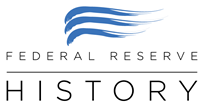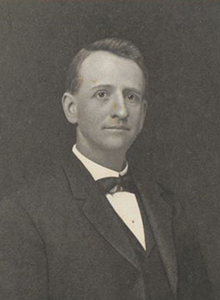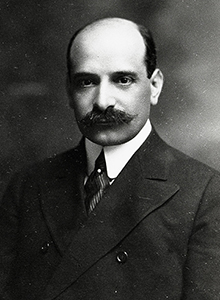Federal Reserve Act Signed into Law
December 23, 1913

With the nation confronting another financial crisis in 1907, and the United States the only one of the world's major financial powers without a central bank, the nation was forced to turn to Wall Street. Finance mogul J.P. Morgan, who had bailed the government out of a financial crisis in 1895, organized private sector investments and lines of credit to stabilize the banking system amid its latest panic.
Recognizing that the nation could not continue to rely on wealthy individuals to stem an economic and financial crisis, Congress passed the Aldrich-Vreeland Act on May 30, 1908. The legislation provided for the issuance of emergency currency and created the eighteen-member National Monetary Commission, chaired by Sen. Nelson Aldrich, to determine what changes were necessary to the nation's monetary system and laws related to banking and currency.
Over the next three years, the Commission traveled to the major capitals of Europe and hosted a number of hearings in the United States. In January 1911, Aldrich unveiled a plan that, after a year of revision by the Commission, was presented to Congress in 1912 and called for a National Reserve Association.
Although the bill did not come forward until 1912, it had been under development for years, going back to a November 1910 meeting investment banker Paul Warburg, Treasury official Abram Piatt Andrew, and others on Jekyll Island, Georgia. The then-secret meeting was organized by financiers and bankers who recognized the nation's need for a central bank and wanted to begin the process. Because they did not think the public would welcome a plan crafted in part by bankers, they made extraordinary efforts to keep the meeting secret, using only first names and telling others they were on a duck hunting trip.
Aldrich's proposal was attacked by committees in both chambers for giving too little control to the government and too much power to bankers, especially those who ran the largest institutions. Among other features, the plan called for a forty-six-member Board with only six appointed by the government and one of those—the head of the organization—selected from a list of three names supplied by the association. Unlike the First and Second Banks of the United States, the government would have no stake in the National Reserve Association.
After the 1912 election, any chance the Aldrich plan had of success was gone. Opposition to the proposal was a plank in the Democratic platform.
With Democrat Woodrow Wilson winning the presidential election and Democrats holding control of both houses, the banking community, which had strongly backed the Aldrich plan, became anxious about what plan the new administration would propose.
The House Banking and Currency Committee assigned a subcommittee under the leadership of Rep. Carter Glass to explore reform proposals. Glass quickly enlisted the help of Henry Parker Willis, a professor at Washington and Lee University. Willis, who also wrote for the New York Journal of Commerce, would come to wield enormous influence over a subcommittee whose members had little knowledge of banking and finance.
The legislation Glass introduced had some aspects in common with the Aldrich plan, but there were some major differences. While Aldrich would have created a central body, the Glass bill provided for a system of regional banks. Glass, in fact, favored as many as twenty regional banks throughout the country and did not like the idea of a central coordinating board.
Glass also believed firmly in autonomous regional banks, later writing in a memoir: "In the United States, with its immense area, numerous natural divisions, still more numerous competing divisions, and abundant outlets to foreign countries, there is no argument, either of banking theory or of expediency, which dictates the creation of a single central banking institution, no matter how skillfully managed, how carefully controlled, or how patriotically conducted."
Glass also did not like the idea of government control. Like Aldrich, his plan gave most of the authority to bankers. Wilson, however, felt the plan needed an oversight agency. He also believed strongly that neither Congress nor the public would support a proposal that gave the government little control.
Early on, Glass had suggested that the comptroller of the currency perform a coordinating function over the system, but Wilson favored a central board. A provision creating the Federal Reserve Board was added to exercise supervisory authority over the banks. It was made up entirely of presidential appointees: either ex officio members because of their cabinet positions or appointees to the Board for specific terms. To provide bankers with a voice, Wilson also created the Federal Advisory Council, a group of twelve bankers elected by the regional banks that would occasionally meet with the Board.
Much of the early congressional criticism of the bill focused on the fact that Glass's subcommittee had largely done its work secretly, with Republicans having little involvement in crafting the legislation. The more substantive debate, however, focused on the issues of control, especially the power of the central board.
In the Senate, the debate was generally much more informed and varied than in the House, with senators generally favoring more centralization. Support also began to emerge for a measure offered by Oklahoma Democratic Sen. Robert L. Owen, which was similar to the House bill but with a few changes, such as limiting the number of Reserve Banks to no more than twelve.
Owen also removed the secretary of agriculture and the comptroller of currency from the Federal Reserve Board and changed the capital of the system to 6 percent of member banks' capital and the surplus from 20 percent of capital in the House bill. The move was seen as favorable to smaller banks, and Owen's bill prevailed.
There were certainly differences between the final bills that passed both chambers, but they had much in common. Matters worked out in committee included the number of Reserve Banks, which ended up specifying between eight and twelve, and the makeup of the Federal Reserve Board, including the return of the comptroller of the currency to the Board. As far as the terms of the Federal Reserve governors, they agreed on staggered terms and extended them from the six or eight years in the approved bills to ten to ensure no president could appoint all governors during a two-term presidency.
The Federal Reserve Act was signed by President Wilson on December 23, 1913.
Bibliography
Glass, Carter. An Adventure in Constructive Finance. New York: Doubleday, Page and Co., 1927. Available on FRASER.
Adapted from: Todd, Tim. "The Federal Reserve Act." In The Balance of Power: The Political Fight for an Independent Central Bank, 1790-Present, 9-15. Kansas City: The Federal Reserve Bank of Kansas City, 2012. Available online.
West, Robert Craig. Banking Reform and the Federal Reserve, 1863-1923. Ithaca: Cornell University Press, 1974.
Wicker, Elmus. Great Debate on Banking Reform: Nelson Aldrich and the Origins of the Fed. Ohio State University Press, 2005.
Written as of November 22, 2013. See disclaimer and update policy.



 X
X  facebook
facebook
 email
email